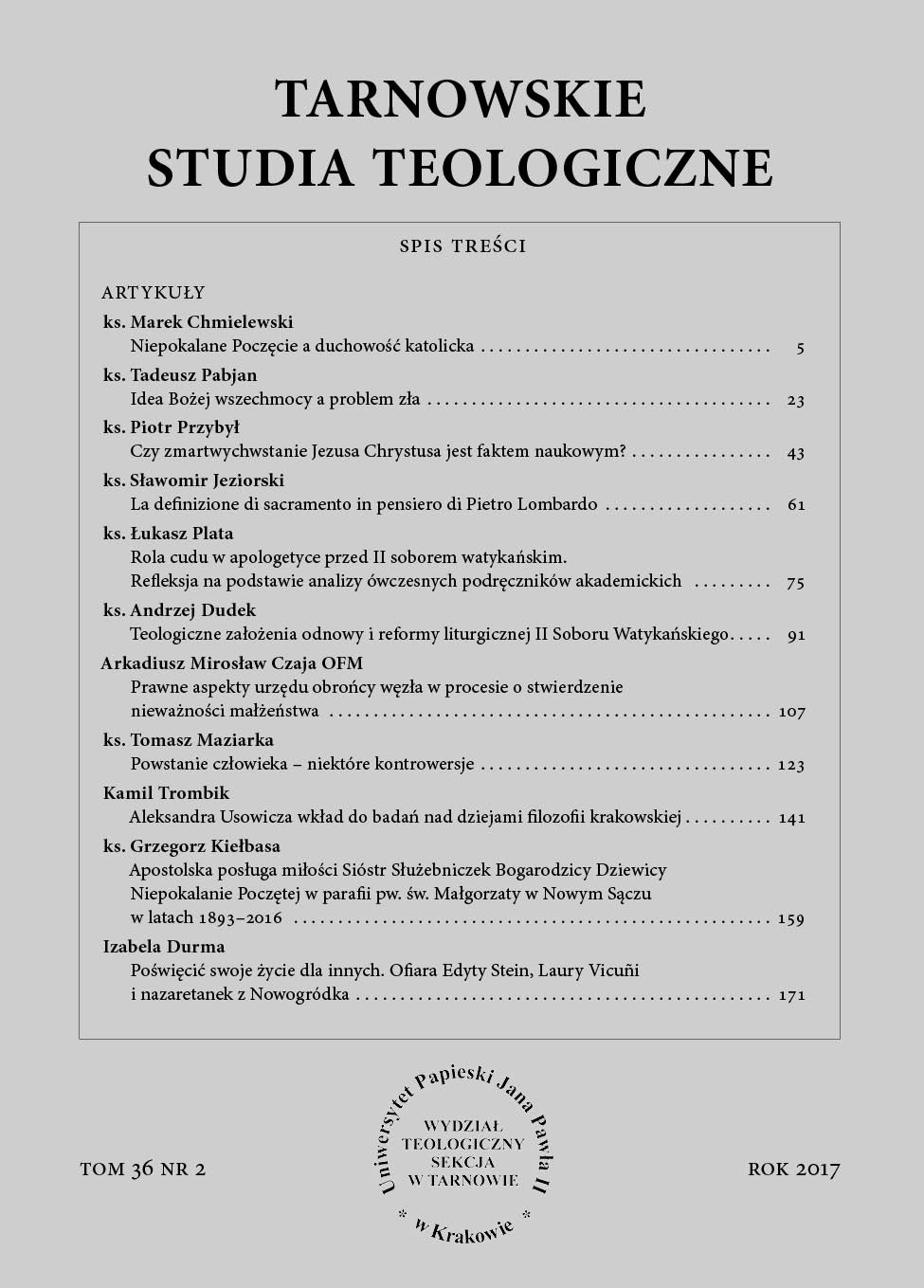The Immaculate Conception and the Catholic Spirituality
DOI:
https://doi.org/10.15633/tst.2612Keywords:
Immaculate Conception, catholic spirituality, Mary’s devotion, Trinity, Jesus Christ, christian antropologyAbstract
According to the pope John Paul II the dogma of the Immaculate Conception is a marvelous doctrinal synthesis of the Christian faith (Angelus, 8.12.1988). In the light of this dogma the essential issues concerning the spiritual life are demonstrated fully and exactly.
The author of this article, analyzing the truth about the Immaculate Conception as an opus of the Holy Trynity in the Mary’s person, shows in rough how that main mariological question impacts and inspires the catholic spirituality.
Therefore at this angle the author looks into the christological dimension of the Immaculate Conception, as well the action of the Holy Spirit, ecclesiastical, anthropological and personalistic aspect of this mystery.
References
Billini Santamaria F.-X., Maria Rosa Mistica, Bloomington 2011.
Camusso M., L’unione mistica mariana. Experienza e teologia, Milano 1969.
Chmielewski M., Duchowe i mistyczne doświadczenie Maryi zamieszkiwania w Niej Trójcy Świętej, „Salvatoris Mater” 2 (2000) nr 3, s. 251–267.
Chmielewski M., Mistologia, w: Encyklopedia katolicka, t. 12, red. E. Ziemann, Lublin 2008, k. 1275–1277.
Czaja A., „Matka Kościoła” w perspektywie eklezjologii „communio”, „Salvatoris Mater” 4 (2002) nr 2, s. 74–88.
Dizionario cronologico delle apparizioni della Madonna, Casale Monferrato 19967.
Grignon de Montfort L., Tajemnica Maryi, Poznań 1982.
Jan Paweł II o Matce Bożej 1978–1998, red. A. Szostek, t. 1–5, Warszawa 1998–1999.
Kochaniewicz B., Maryja ikoną Trójcy Świętej. Próba teologicznej syntezy, „Salvatoris Mater” 2 (2000) nr 3, s. 26–61.
Kowalik K., Per Mariam ad Iesum. Per Iesum ad Mariam, „Salvatoris Mater” 3 (2001) nr 2, s. 22–33.
Kowalik K., Trynitarna perspektywa kultu maryjnego w Polsce, w: Recepcja „Marialis cultus” w Polsce, red. J. Kumala, Licheń 2004, s. 55–74.
Królikowski J., Wątki eklezjalne w mariologii w recepcji VIII rozdziału Konstytucji „Lumen gentium”, „Salvatoris Mater” 16 (2014) nr 1–4, s. 27–36.
Kumala J., Perspektywa trynitarna tajemnicy niepokalanego poczęcia Maryi w nauczaniu Jana Pawła II, „Salvatoris Mater” 3 (2001) nr 1, s. 199–214.
Lekan J., Chrystologiczny wymiar „via pulchritudinis” w mariologii, „Salvatoris Mater” 15 (2013) nr 1–4, s. 31–47.
Liszka P., Maryja we współczesnych traktatach o Trójcy Świętej, „Salvatoris Mater” 2 (2000) nr 3, s. 62–93.
Łaszewski W., Karl Rahner i jego antropologiczna próba rozumienia niepokalanego poczęcia, „Salvatoris Mater” 3 (2001) nr 1, s. 215–237.
Misiurek J., Doświadczenia mistyczne Maryi, w: Signum Magnum – duchowość maryjna, red. M. Chmielewski (Homo Meditans, 23), Lublin 2002, s. 137–147.
Napiórkowski S. C., „Per Jesum ad Mariam”. Interpretacja wypowiedzi Jana Pawła II, w: Przez Jezusa do Maryi, red. S. C. Napiórkowski, K. Pek (Biblioteka Mariologiczna, 4), Częstochowa–Licheń 2002, s. 9–21.
Papieska Międzynarodowa Akademia Maryjna, Matka Pana. Pamięć – obecność – nadzieja. Niektóre aktualne zagadnienia dotyczące postaci i misji Najświętszej Dziewicy Maryi, Watykan 2000, „Salvatoris Mater” 4 (2003) nr 3, s. 311–398.
Paszkowska T., Antropologiczny wymiar piękna Maryi, „Salvatoris Mater” 15 (2013) nr 1–4, s. 89–106.
Rypens L., Rosa mystica. Marie et la mystique, w: Maria. Études sur la sainte Vierge, éd. H. du Manoir, t. 1, Paris 1949, s. 745–763.
Schreiber M. A., L’uomo immagine di Dio. Principi ed elementi di sintesi teologica, Roma 1987.
Siudy T., Droga piękna w mariologii, w: Całaś piękna jest, Maryjo. Mariologia na drodze piękna, red. G. M. Bartosik, J. Karbownik (Biblioteka Mariologiczna, 13), Częstochowa 2009, s. 36.
Trójca Święta a Maryja, red. T. Siudy, K. Pek, Częstochowa 2000.
Wojtczak A., Uczennica i Matka. Wokół chrystocentryzmu mariologii Jana Pawła II, Poznań 2005.
Downloads
Published
Issue
Section
License
Authors who publish with this journal agree to the following terms:
- Authors retain the copyright and full publishing rights without restrictions, and grant the journal right of first publication with the work simultaneously licensed under a Creative Commons Attribution 4.0 International License that allows others to share the work with an acknowledgement of the work's authorship and initial publication in this journal.
- Authors are able to enter into separate, additional contractual arrangements for the non-exclusive distribution of the journal's published version of the work (e.g., post it to an institutional repository or publish it in a book), with an acknowledgement of its initial publication in this journal.
- Authors are permitted and encouraged to post their work online (e.g., in institutional repositories or on their website) prior to and during the submission process, as it can lead to productive exchanges, as well as earlier and greater citation of published work (See The Effect of Open Access).

